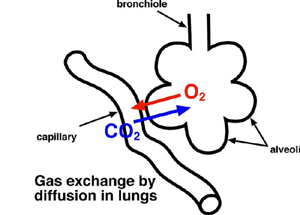Why we have lungs
So does that mean that diffusion has no place in gas exchange of larger organisms? Not at all. Once air is in the lungs, gases get exchanged though...none other than diffusion. The lung is subdivided, ultimately, into millions of tiny sacs called alveoli, each of which has a thickness of only 0.5 to 1 micrometer. Each alveolus is surrounded by capillaries,and it takes blood about 1 second to pass
 |
|
However, when you get a nasty cold, or a case of pneumonia, the lung tissue can swell and thicken enough to endanger your ability to breathe!
There’s a second place where diffusion is vital in gas exchange: capillaries are the very thin, small blood vessels through which gases are exchanged with cells. The cells making up the walls of the capillaries are around 1 micrometer thick, so gases can diffuse directly through them in the same amount of time as above (0.0005 seconds).

Incidentally, nutrients -- such as glucose, amino acids and lipids -- and metabolic wastes also diffuse to and from the capillaries. Capillaries in different parts of your body even differ in their permeability – that is, the diffusion coefficient D varies. So entire proteins can diffuse in and out of liver cells, while almost nothing gets to or from the brain cells except oxygen and carbon.
Copyright University of Maryland, 2007
You may link to this site for educational purposes.
Please do not copy without permission
requests/questions/feedback email: mathbench@umd.edu
